Yellow Crane Tower
Wuhan’s Iconic Landmark Guide
The Legendary Yellow Crane Tower: Wuhan’s Timeless Cultural Icon
The Yellow Crane Tower stands as one of China’s most iconic ancient landmarks, majestically perched atop Snake Hill overlooking the mighty Yangtze River in Wuhan. With a history that stretches back over 1,700 years, the tower’s name is steeped in legend—told of a sage who ascended to heaven riding a yellow crane from this very spot, symbolizing immortality and hope.
More than a breathtaking architectural masterpiece, the Yellow Crane Tower captures the essence of China’s literary and cultural heritage. It has inspired countless poets throughout the centuries and serves as a timeless bridge connecting history with the present. As a UNESCO-recognized cultural treasure, the tower welcomes millions of visitors annually, offering spectacular views and a deep dive into the rich stories of Chinese history, culture, and natural beauty.

History of the Yellow Crane Tower
The Yellow Crane Tower was originally built in 223 AD during the Three Kingdoms period, making it one of China’s oldest and most revered landmarks. Over centuries, it has been destroyed and rebuilt multiple times, with each reconstruction reflecting the architectural styles and cultural influences of dynasties like the Tang, Song, Ming, and Qing.
The tower’s name comes from a famous legend about a sage who rode a yellow crane to heaven from this very spot, symbolizing immortality and hope. This story has deeply influenced Chinese culture, making the tower a symbol of spiritual transcendence and poetic inspiration.
Throughout history, the Yellow Crane Tower has inspired countless poets and artists, especially during the Tang dynasty. Today, the modern reconstruction stands as a proud cultural icon in Wuhan, embodying centuries of history, myth, and literary significance.
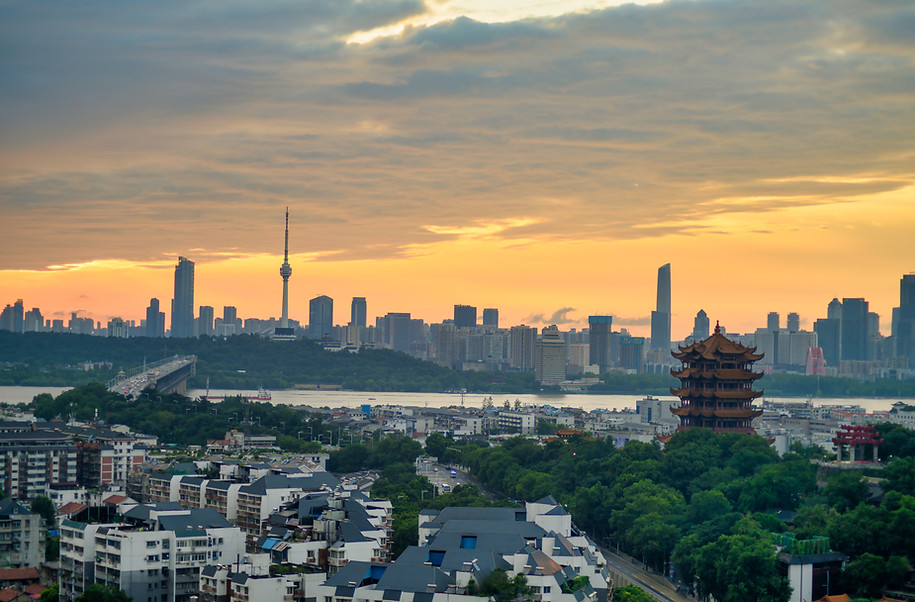
Architecture and Structure of Yellow Crane Tower
The Yellow Crane Tower stands impressively at approximately 51 meters (167 feet) tall, making it one of the tallest historic towers in China. Its multi-storied wooden structure features elegantly curved eaves and traditional Chinese architectural details that showcase the grandeur of ancient design. The tower’s height and distinctive silhouette against the Wuhan skyline make it a captivating sight for visitors and photographers alike.
The architectural style of the Yellow Crane Tower reflects a blend of classical Chinese elements, characterized by its ornate carvings, vibrant colors, and tiered rooftops. Over the centuries, the tower has undergone several renovations and reconstructions due to natural wear, wars, and fires. Each restoration preserved its iconic form while incorporating improvements to withstand the test of time, ensuring the tower remains a symbol of resilience and cultural pride.
Surrounding the tower is the Yellow Crane Tower Scenic Area, a beautifully landscaped park that complements the historical structure. The park offers serene walking paths, gardens, and panoramic views of the Yangtze River, creating a peaceful environment for tourists to explore. This scenic area not only enhances the visitor experience but also preserves the cultural and natural heritage of the site, making it a must-visit attraction in Wuhan, China.

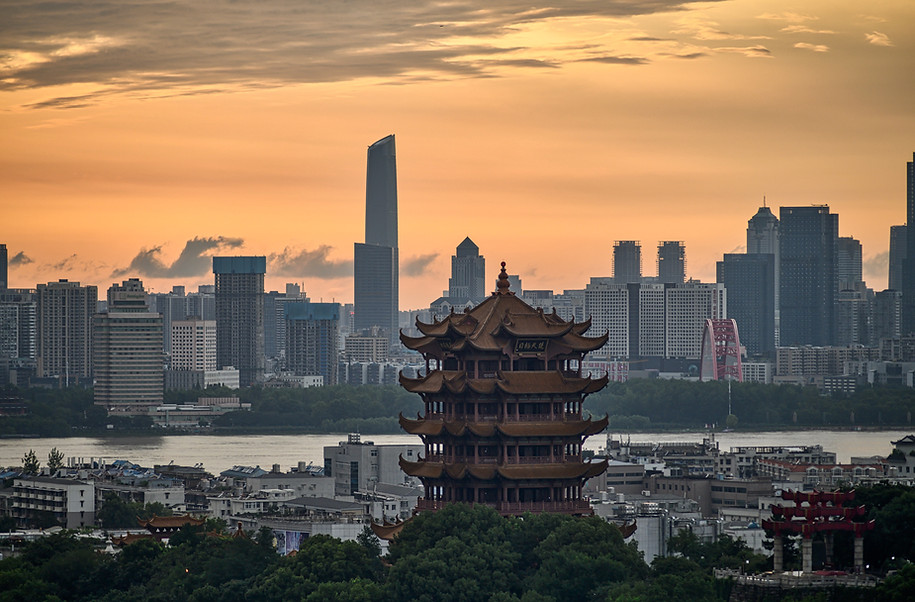
Symbolism and Cultural Significance
The Yellow Crane Tower is a profound symbol of immortality, hope, and spiritual transcendence in Chinese culture. Its iconic architecture, with curved eaves resembling crane wings, represents the ancient belief that cranes are spiritual messengers. According to legend, a sage once ascended to heaven from this spot on a yellow crane, leaving behind a lasting legacy of mystery and enlightenment. This story, immortalized by Tang dynasty poet Cui Hao, has made the tower a poetic symbol of longing and nostalgia, celebrated throughout centuries of Chinese literature.
Today, the Yellow Crane Tower remains a symbol of Wuhan’s cultural identity and historical pride. As a UNESCO-listed cultural site, it draws visitors from around the world who admire its architectural beauty and the timeless legends surrounding it. The tower’s enduring presence in literature, art, and tourism reflects its role as more than just a historical monument—it is a living testament to China’s rich heritage and artistic inspiration.

Visitor Information and Travel Tips
Visiting the Yellow Crane Tower in Wuhan, China is an enriching experience, combining historical exploration with scenic views. Situated on Snake Hill near the Yangtze River, it is one of the most iconic landmarks in Hubei Province. Here’s everything you need to know to plan your visit efficiently.
Transportation from Wuhan Airport and Other Access Points
The Yellow Crane Tower is conveniently accessible from Wuhan Tianhe International Airport, located about 30 kilometers away. Visitors can take a taxi, which typically takes around 40 minutes, or use public transport for a more budget-friendly option. The Wuhan Metro Line 4 stops at Yellow Crane Tower Station, just a short walk from the site. Local buses, including routes 10, 61, and 401, also serve the area. For those traveling by train, Wuchang Railway Station is just a few kilometers away, making it a quick ride by taxi or bus.
Opening Hours and Entry Tickets
The Yellow Crane Tower is open to visitors daily from 8:00 AM to 6:00 PM. However, it’s advisable to check official announcements, as hours may vary during holidays or special events. The entrance fee is around 80 CNY (approximately $12 USD) per person. Tickets can be purchased at the gate or online through various travel apps and official websites. Booking in advance helps avoid long queues, especially during peak seasons.
Recommended Duration for Visiting the Tower
Exploring the Yellow Crane Tower Scenic Area typically takes around 1 to 2 hours. This includes time to appreciate the tower’s architectural details, explore the exhibitions on each floor, and enjoy panoramic views from the top. Don’t rush through; take time to immerse yourself in the history, legends, and artistic elements that make this site so significant.
Best Times and Seasons to Visit
The best time to visit the Yellow Crane Tower is during spring (March to May) and autumn (September to November). These seasons offer mild weather, clear skies, and lush gardens in the scenic area. Summer visits can be hot and humid, while winter can be quite chilly, but the tower remains a popular attraction throughout the year. Early morning or late afternoon visits are recommended to avoid crowds and capture the best photos.
Hotels Near Yellow Crane Tower
For a comfortable stay, consider nearby accommodations such as the Wuhan Jinjiang International Hotel, known for its modern amenities and proximity to the tower. Other convenient options include the Hanting Express Wuhan Yellow Crane Tower and the Holiday Inn Wuhan Riverside. Staying in this area allows easy access to both the tower and other local attractions, including the Yangtze River Bridge and Hubu Alley.

Practical Tips for Visitors
To make the most of your visit, wear comfortable shoes as the area involves some walking and slight uphill paths. Carry a camera for capturing the stunning architectural features and panoramic views from the tower’s top floor. It’s also a good idea to bring water, especially during warmer months. Early morning visits are ideal to avoid crowds, and taking a guided tour can enhance your understanding of the site’s rich cultural history.
Photography and Visual Appeal
The Yellow Crane Tower in Wuhan, China is a captivating subject for photographers, renowned for its vibrant yellow tiles, curved eaves, and panoramic views of the Yangtze River. One of the best spots to capture the tower’s grandeur is from the Yangtze River Bridge, offering a wide perspective of the structure against the city skyline. Inside the Scenic Area, garden paths and pavilions also provide excellent vantage points to photograph both the tower and the lush surroundings.
Popular Yellow Crane Tower photos often highlight its architectural elegance, especially during the golden hour or nighttime when the tower glows with illuminated charm. To capture the full aesthetic appeal, use a wide-angle lens for landscape shots and a telephoto lens to focus on ornate details like the dragon motifs and calligraphy adorning the walls.
Nearby Attractions and Activities
Surrounding the Yellow Crane Tower, the Yellow Crane Tower Park offers serene gardens and scenic pathways perfect for relaxation and photos. Nearby, visitors can explore historic sites like the Yangtze River Bridge and the Wuchang Uprising Memorial. For food lovers, Hubu Alley provides an authentic taste of Wuhan’s street food, featuring specialties like hot dry noodles and Wuhan Doupi. Souvenir shops near the tower sell traditional crafts and mini replicas, making it easy to bring home a piece of Wuhan’s cultural heritage.



Exploring the Yellow Crane Tower: A Journey Through History, Culture, and Scenery
The Yellow Crane Tower, an iconic landmark in Wuhan, is far more than a single tower; it is a sprawling park brimming with historical significance, cultural richness, and diverse scenic areas. A visit to this renowned site promises an immersive experience into the heart of Wuhan's heritage.
1. The Park and Its Scenic Zones
The Yellow Crane Tower Park is divided into distinct areas, each offering unique attractions:
- East Area - Yue Fei Scenic Area: This zone is steeped in the legacy of Yue Fei, a revered historical figure, and is a repository of historical and cultural memories.
- West Area - Scenic Spot Area: It is a collection of well - known scenic spots that showcase the natural and man - made beauty of the region.
- South Area - Cultural Area: Here, the focus is on exhibiting various cultural elements, from traditional art to local customs.
- North Area - Vegetation and Garden Area: Lush vegetation and beautifully designed gardens create a serene and picturesque environment.
In total, there are over 60 scenic spots within the park. What makes the visit even more intriguing is the existence of three gates, each leading to a different tourist route. This allows visitors to tailor their exploration according to their personal interests, whether they are history buffs, nature lovers, or culture enthusiasts.
2. Notable Attractions Beyond the Main Tower
Shengxiang Pagoda
Shengxiang Pagoda has a long - standing connection with the Yellow Crane Tower. While the Yellow Crane Tower was destroyed during the Qing Dynasty, Shengxiang Pagoda survived intact. Later, during the construction of the Yangtze River Bridge, it was relocated. With a unique historical background, it was once mistakenly referred to as the "Kongming Lantern" due to ancient legends. However, it is essentially a Lama Pagoda, which was used for religious purposes such as enshrining relics.
"Three Chu One Tower" Memorial Archway
This archway is a testament to the historical division of the Chu State. The phrase "Mountains and Rivers Enter the Painting" on the other side of the archway has a special origin. It is related to the geographical environment and the scenic beauty of the Yellow Crane Tower in the past. In earlier times, the Yellow Crane Tower stood by the Yangtze River, and Wuhan had no high - rise buildings and was dotted with many lakes. When one stood on the tower, all that could be seen were the mountains and the mist over the river, making people feel as if they had stepped into a painting. Hence, the phrase "Mountains and Rivers Enter the Painting" was coined.
Bronze Statue Symbolizing the Return of the Yellow Crane
This statue is intertwined with legends about Tortoise Mountain and Snake Mountain. It also embodies the significance of the reconstruction of the Yellow Crane Tower, representing the idea of the yellow crane's return.
The Neighboring Pavilion (Linked to Li Bai's Doggerel)
This pavilion is steeped in literary lore. Li Bai, a great poet, once visited the Yellow Crane Tower with the intention of composing poems and fu. However, upon seeing the magnificent scenery and a poem left by Cui Hao on the tower, he was so impressed by Cui Hao's work that he left a doggerel: "In front of my eyes, there are scenes that I can't describe; Cui Hao's poem is on the top." After leaving this doggerel, Li Bai put down his pen and departed, adding a layer of literary allure to the Yellow Crane Tower.
Baotong Top
As a cultural relic from the Qing Dynasty, Baotong Top has endured many hardships. In 1958, someone cut off its top for iron - smelting, and in 1981, part of its upper section was sawn off and sold. Fortunately, through the joint efforts of the Wuhan Machinery Research Institute and Qingshan Shipyard, this precious cultural relic was restored.
3. The Floors of the Yellow Crane Tower
The Yellow Crane Tower itself has five floors, each with a distinct theme:
- First Floor: Myths: It delves into the mythical stories and legends associated with the tower.
- Second Floor: History: This floor showcases the long and eventful history of the Yellow Crane Tower and the surrounding region.
- Third Floor: Academic Papers: It presents academic research and discussions related to the tower's history and culture.
- Fourth Floor: Reception: Serving as a space for receiving guests, it also offers a place for rest and reflection.
- Fifth Floor: Heavy - Colored Murals: Adorned with elaborate murals, this floor is a visual feast, displaying artistic expressions related to the tower's heritage.
Each floor provides a different perspective and experience, enabling visitors to gain a comprehensive understanding of the history, culture, and art associated with the Yellow Crane Tower.
In conclusion, the Yellow Crane Tower is a destination that seamlessly blends history, culture, and natural beauty. Whether you are fascinated by historical allusions, eager to explore cultural heritage, or simply wish to soak in the poetic scenery, a visit to the Yellow Crane Tower is sure to be a rewarding and enriching experience.



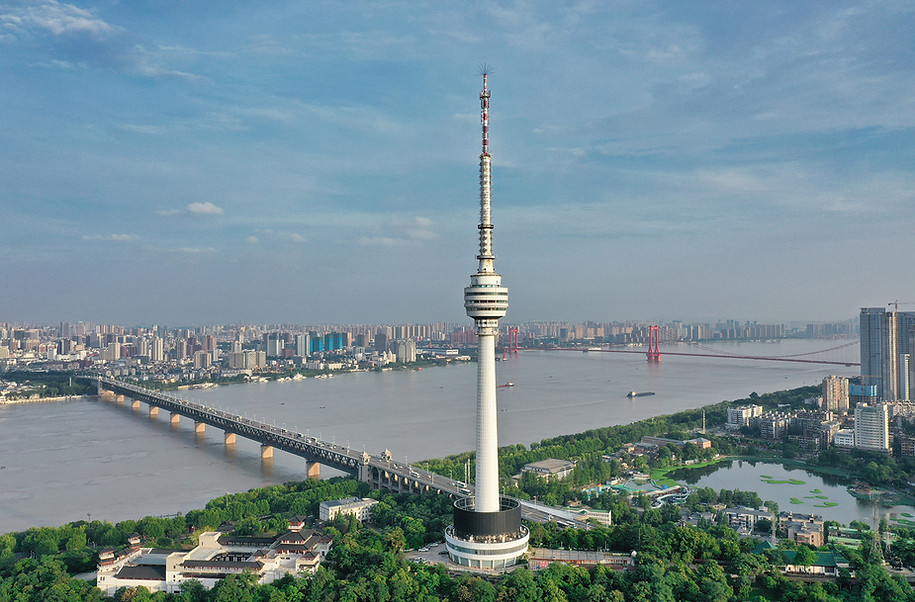
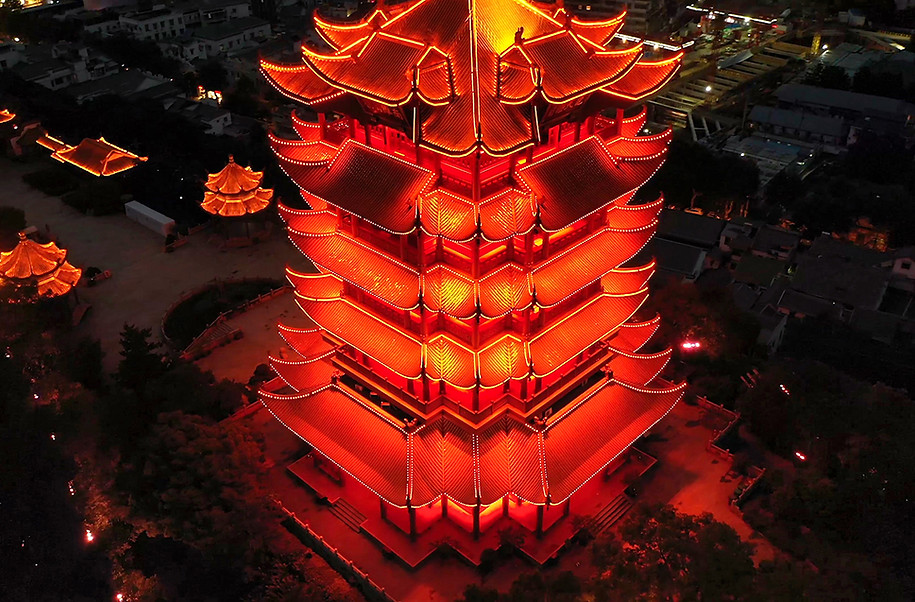
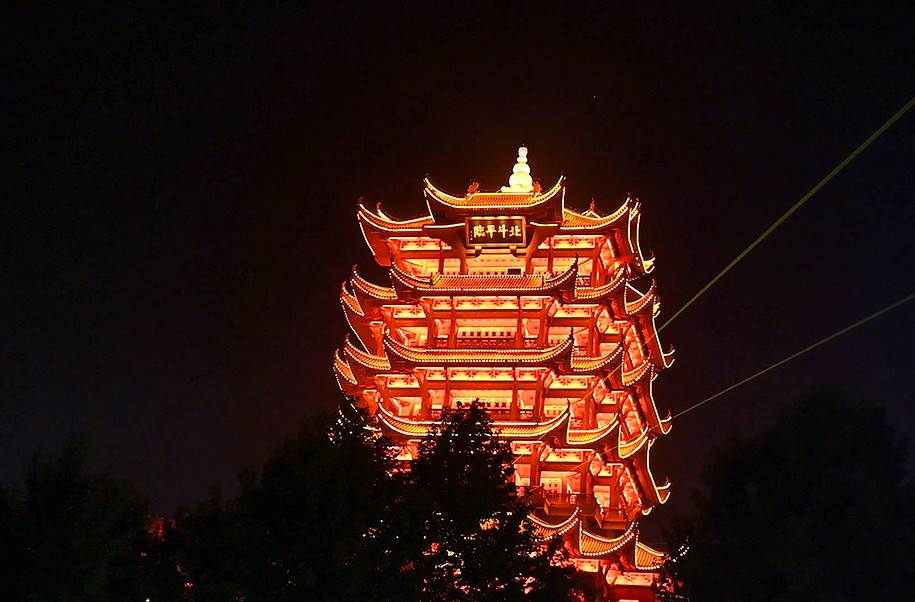
FAQS ABOUT YELLOW CRANE TOWER
How long should visitors spend at the Yellow Crane Tower?
Visitors typically spend 1 to 2 hours exploring the tower and surrounding scenic area.
What are the opening hours of the Yellow Crane Tower?
The tower is open daily from 8:00 AM to 6:30 PM. Sometimes open during evening.
How tall is the Yellow Crane Tower?
The current Yellow Crane Tower stands approximately 51 meters (167 feet) tall.
How to get to Yellow Crane Tower from Wuhan Airport?
From Wuhan Tianhe International Airport, take a taxi (around 40 minutes) or use public transportation—Wuhan Metro Line 2 to Line 5 to Yellow Crane Tower Station is the most convenient option.
Conclusion
The Yellow Crane Tower is a historic and cultural treasure of Wuhan, offering stunning views, rich legends, and a deep connection to Chinese heritage. Whether you're interested in history, architecture, or simply breathtaking scenery, it’s a must-visit landmark. Experience the tower’s timeless charm and vibrant surroundings by booking a guided tour today—visit our Contact Page to plan your unforgettable visit!
Book a Tour With Us
Unlock Wuhan’s Secrets: Premium Tours with Certified English Guides
Why Choose Our Expert-Led Excursions in Wuhan?
1. "Living Guidebook" Depth
2. Zero Language Barrier
3. Safety Guarantee & Quick Access
4. Hyperlocal Story Weaving
Upgrade Your Trip with One Click:
Don’t just see Wuhan – converse with it through certificated guide who speak it in depth.
Book Now →



Loading days...
8 hr
2,100人民币Loading days...
Duration Varies
From 1,150人民币
Yellow Crane Tower: A Historic Icon Overlooking Wuhan
The Yellow Crane Tower is one of Wuhan’s most iconic landmarks, steeped in history and offering spectacular views of the city. With its striking architecture and rich cultural significance, this ancient tower has inspired poets and artists for centuries. Located on the banks of the Yangtze River, it’s a must-visit for those looking to connect with Wuhan’s past while enjoying panoramic views of the cityscape.
-
Transportation – Easy access to Yellow Crane Tower from city center
-
Culture & Heritage – A deep dive into the tower’s historical importance
-
Wuhan Architecture & Hankou Concession – Explore the blend of ancient and modern architecture
-
People & Life – Discover local customs and legends associated with the tower
-
Nature in Wuhan – Enjoy the surrounding parks and views of the Yangtze
Explore more with our cultural tours, scenic itineraries, and photography spots around Yellow Crane Tower.







